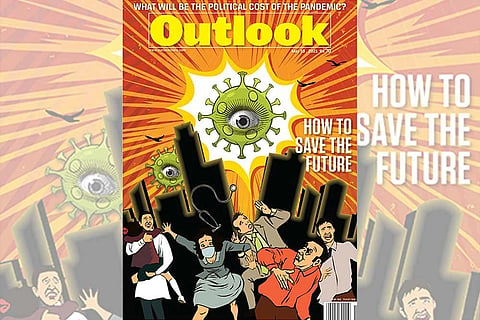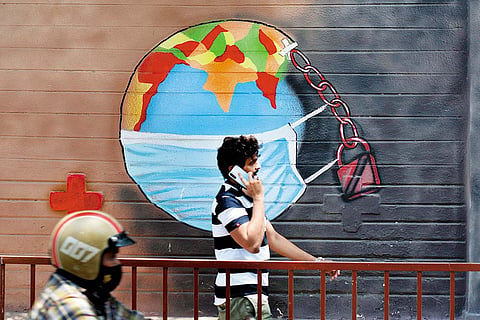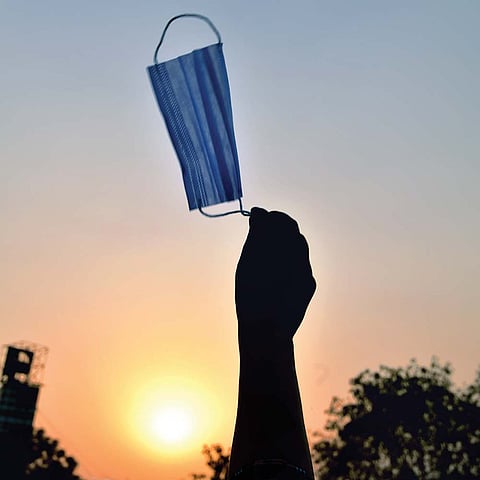As Covid patients die for want of hospital beds and oxygen, are there any immediate solutions to overcome the crisis? How can we save people from dying due to lack of health facilities? The only way is to increase the number of hospital beds, deploy a large number of trained medical professionals and ensure an adequate supply of oxygen—and to do all of this almost overnight. It looks impossible, but healthcare workers on the ground say, “If there is a will, there is a way.” According to them, the deluge of patients is not so huge that our healthcare system cannot treat them by quickly putting in place a parallel health infrastructure to take the load away from existing hospitals.
Beating The Virus A Survival Guide
What can we do to save more lives than we are being able to?
“Even if we put our best foot forward, we cannot save everyone, but we can definitely save a lot of patients who are dying today due to lack of health facilities,” says a doctor at the Covid care centre in the Commonwealth Games Village, Delhi. Healthcare workers say the chaos is due to non-augmentation of available resources and an indecisive and unfocussed approach, leading to mismanagement and lack of prompt action. According to health experts, all is not lost yet and thousands of lives can still be saved if the Centre and the states start working in tandem with a proactive approach.
ALSO READ: The Missing Link Public Health
Reasonable Hospitalisation
The first and foremost need is to identify the patients who need hospitalisation. Dr Randeep Guleria, director of the All India Institute of Medical Sciences (AIIMS), Delhi, says 85 per cent of Covid patients show only mild symptoms and don’t need to be in a hospital. “However, due to panic, even they get admitted. Such patients need to be in home isolation with close monitoring and should be hospitalised only in case their condition deteriorates,” says Dr Guleria.
Health experts say it is easy to advise patients, but everybody is in panic due to the extreme shortage of beds. Many senior doctors in private hospitals tell Outlook that those who don’t need hospitalisation are occupying 20 to 40 per cent of the beds. “They have recommendations from bureaucrats and politicians, and they can afford to pay. But they don’t realise they are depriving those who really need the beds,” says a senior officer from the hospital administration of Medanta.
Some health experts say the government should have created a centralised 24x7 online medical desk to allocate hospitals to patients based on availability of beds and severity of the infection. “So, instead of patients going straight to the hospital, they would approach the online medical desk that ensures admission to the patient,” says Dr (Major) Gulshan K. Garg (retd), who runs Sankalp, an NGO. “The desk can decide if the patient needs home isolation or hospital care. Experts can also be deputed to inspect the patients if required.” Dr Garg believes that such rationalisation would free up a few thousand hospital beds not only in Delhi, but in other cities as well, and those beds can be allocated to more serious patients who are now dying in the queue outside hospitals. “It is an unprecedented challenge and the government has to rise to the occasion with out-of-the-box solutions as the existing health infrastructure has limited resources,” he adds.
Many other health experts also support the idea and say that an online dashboard with real-time updates on availability of beds can bring transparency and instill confidence among people. The Delhi government has already created an app called Delhi Corona, which shows the total number of Covid hospitals in Delhi and claims to provide real-time updates on the availability of beds with oxygen facilities and ICU beds. Many patients, however, complain that the app is useless as it provides incorrect information. Outlook checked the information in some cases and found the complaints to be true.
ALSO READ: We, The Makers Of This Calvary
Experts say that once the hospitals earmarked for Covid patients get completely occupied, the next step is to send patients to makeshift hospitals. Many public health experts have been advising that doctors and MBBS students from medical colleges in areas that are not seriously affected should be moved to the severely affected areas to meet the demand for health workers.

Makeshift to the Front
The idea of setting up makeshift hospitals to take the load off existing hospitals was floated last year in March when the Covid pandemic hit the country. The Centre and the Delhi government did create some such makeshift hospitals in Delhi, but they were dismantled when the first wave subsided by the beginning of this year. For instance, it had taken the Centre just 12 days to set up the Sardar Vallabhbhai Patel Covid Hospital last year, but it was closed this February after the number of cases came down. The Defence Research and Development Organisation (DRDO) has recently rebuilt the facility. It was opened again on April 26 with 250 ICU beds, and has since seen a huge rush of patients and their relatives, who have been running from pillar to post to get a hospital bed. Many had to return disappointed as it admits only those who need ICU beds and not those for whom beds with oxygen facility would suffice. Another 250 beds are expected to be added within a few days. “If the proposed centralised online medical desk were to handle this makeshift hospital, there would be no need for patients to face harassment and then be asked to go home,” Dr Garg points out.
Dr Ravikant Singh, founder of Doctors For You (DFY), an NGO working in disaster-hit zones across the country for the past 10 years, has set up 14 temporary Covid care centres across the country. Four of them are in Delhi—one each at the CWG Games Village, the Yamuna Sports Complex, the government school at Rouse Avenue and Shaheen Bagh. Health experts say many more such makeshift hospitals need to be set up in big stadiums as the virus in the second wave seems to be almost eight to nine times more infectious than it was during the first wave. But opening a makeshift hospital in Delhi is quite a challenge now due to lack of supply of oxygen. Hoarding of oxygen cylinders too has become a major problem. Doctors have observed that oxygen supply has emerged as the most vital medical need for patients in the second wave as the majority of patients suffer from low oxygen saturation. “Oxygen cylinders are the lifeline of makeshift hospitals in the second wave because patients, irrespective of their age group, experience low oxygen saturation in the body and their lives cannot be saved unless we put them on oxygen support,” says Dr Singh, adding that his four centres in Delhi can treat 2,500 patients, but only 350 beds are functional at present due to lack of oxygen supply and flow meters.

Regulate Supply Chain
It is mindboggling that hospitals are running short of oxygen supply and patients are dying due to lack of oxygen support in a country that produces 7,500 metric tonnes of oxygen every day against the current demand of less than 7,000 metric tonnes for medical purposes. “Against the present demand from 20 states of 6,785 metric tonnes a day of liquid medical oxygen, the government of India has from April 21 allocated 6,822 metric tonnes a day to these states,” reads a recent central government press release. To understand the reason for shortage, one needs to look at the manufacturing process and the supply chain.
ALSO READ: Smother The Third wave
Companies such as INOX, Air Liquid, Goyal Gasses and Linde have air suction plants at various places in the country. They suck air from the atmosphere, separate it into nitrogen, oxygen and argon, and store these in liquid form. Before April 22, over 90 per cent of liquid oxygen used to be supplied to industries for non-medical purposes as its medical use was less than 10 per cent. When Covid cases started rising in March, the central government realised the need to ensure adequate availability of medical oxygen and, on April 4, the ministry of commerce and industry set up a nine-member committee for the purpose. On April 18, the government decided to stop oxygen supply to non-medical industries with effect from April 22. “The four-day window was given so that the ongoing work of non-medical industries did not suffer, but the industries stockpiled a lot of liquid oxygen during that period, while hospitals continued to face an acute shortage,” says an employee of a gas manufacturing company. Moreover, as the Covid situation turned grimmer, many people started hoarding oxygen cylinders without knowing how to use them. “Thousands of filled cylinders are lying at people’s homes,” says a gas-filling station owner in Haryana.
Cylinder distributors play a crucial role in the supply chain as they rent out or sell cylinders to small and medium hospitals, and to individuals for home use. The manufacturers supply liquid oxygen in cryogenic trucks to big hospitals and gas filling stations, which convert liquid oxygen into gas and fill the cylinders owned by various gas distribution firms. These firms supply the cylinders to smaller hospitals and individuals.
Supply-chain stakeholders say the government should think of ways to regulate cylinder distribution companies and filling stations. “The government can ask them not to rent out or sell any cylinder without its permission, and refilling companies should be asked not to fill cylinders brought by individuals,” says a gas-filling station owner in Greater Noida. “These steps, however, should be taken only when the government is in a position to ensure that each and every patient who needs a bed is provided with one.”
There is also an acute shortage of flow meters, a small device that regulates the transfer of oxygen from the cylinder to the patient. This has taken the crisis to another level. “You can produce millions of tonnes of oxygen, but if you don’t escalate the production or procurement of flow meters, which cost less than Rs 500 a piece, all the efforts fail to achieve the desired outcome,” says a senior doctor closely associated with the Union health ministry’s decision-making process. “Many senior officials in the ministry were not aware that oxygen cylinders without flow meters are of no use to patients. Can you believe it?”
Pointing out that many oxygen cylinders at his makeshift hospitals cannot be used due to lack of flow meters, Dr Singh says India has only 6,000 flow meters, while the estimated requirement could be around 2 lakh. “There are only three companies that make flow meters in India. We have ordered 1,000 flow meters from Japan at the cost of around Rs 40 lakh,” he adds.

Care in Isolation
This is another crucial aspect of Covid management that many state governments completely ignored, losing track of patients as the cases piled up. Thousands of patients have been looking for online consultation and guidance, and are following whatever they find on social media networks—often unverified and unnecessary advice. During the first wave, the Delhi government was reasonably successful in providing tele-consultation to patients in home isolation, but this hasn’t happened during the ongoing second wave. Many patients complain that they never got any call from any doctor or other officials of the health department and were left to their own fate. “When I called the office of the district health officer, I was promised that they would call back. They never called,” says a patient who resides in Malviya Nagar.
According to Dr Rahul Bhargava, director of the department of clinical haematology and bone marrow transplant at Fortis Hospital, Gurgaon, a regular monitoring call from a government doctor can boost a patient’s morale and have a soothing effect on the psyche. “Today, the biggest problem is panic among patients as they don’t know what to do if the oxygen saturation level goes down or if they feel uneasy,” he says. “Providing care and psychological comfort to a patient is the most powerful medicine and the government should utilise this magic prescription to save lives.”
Dr Guleria says there are breathing techniques such as prone breathing that can improve the oxygen saturation of patients isolated at home. Paediatrician Dr Kafeel Khan, earlier associated with BRD Medical College, Gorakhpur, says many of his patients recovered with just paracetamol and adequate liquid intake to keep the body hydrated. “Due to the lack of proper tele-counselling, people are falling prey to quacks and fake doctors,” says Dr Khan, adding that he would not encourage people to have oxygen cylinders at home unless they have a trained doctor or healthcare professional there.
A senior government doctor, who requested not to be identified, says that the response of an individual’s body to any disease is always unique and there is no golden rule that the patient must rush to a hospital if the oxygen saturation level comes down to 89. “I have patients isolated at home whose oxygen saturation level came down to 82. I advised them not to panic, but to calm down and do prone breathing. Within a few hours, they called back and said the level has gone above 90,” he says, adding that this is possible only when the patient is under the observation of a trained medical practitioner and is sure that there won’t be a problem getting admitted to a hospital if the oxygen level goes further down.
Oxygen at Home
Thousands of people are buying oxygen concentrators or cylinders with flow meters to deal with decreasing oxygen saturation levels. Experts say this needs to be done under supervision as the need for oxygen depends on the patient’s requirements and health conditions. “People are wasting precious resources as they don’t know whether they need oxygen support or not,” says Dr Khan. Some experts advise that those who need oxygen support, but fail to get beds in hospitals, can buy an oxygen concentrator that sucks oxygen from the atmosphere and lets the patient inhale it. It can fulfill the requirement of patients whose oxygen level dips, but remains above 82. A portable oxygen cylinder with a valve regulator or B-type oxygen cylinder with a flow meter can also be installed at home with the help of experts.
All these products, however, have vanished from the market. “These are life-saving products and the government should regulate their sale by issuing appropriate guidelines. Instead of people going and buying these, government doctors who provide tele-counselling to the patients should advise and monitor their use,” says Dr Garg.